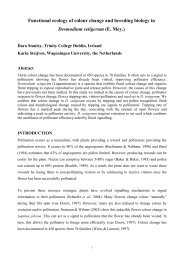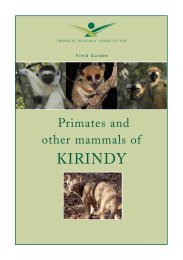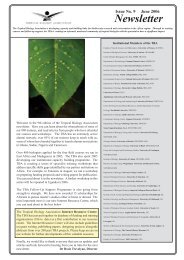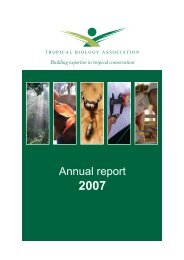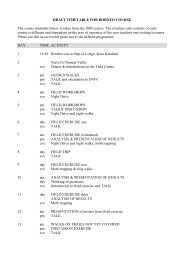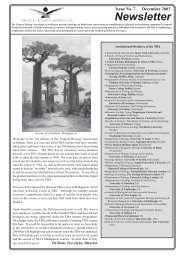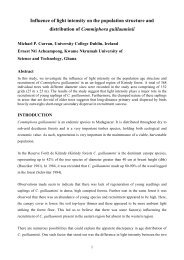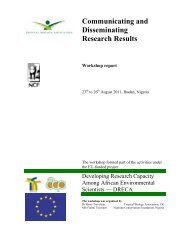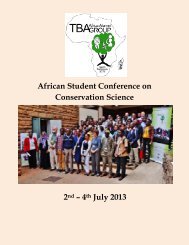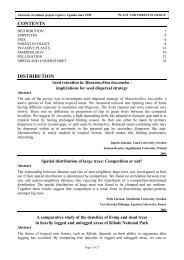Download TAAG Book of Abstracts - Tropical Biology Association
Download TAAG Book of Abstracts - Tropical Biology Association
Download TAAG Book of Abstracts - Tropical Biology Association
You also want an ePaper? Increase the reach of your titles
YUMPU automatically turns print PDFs into web optimized ePapers that Google loves.
Periphyton as Inorganic Pollution Indicators in<br />
Themara River, Kenya<br />
*Mbao O. Evance, NzulaKitaka, Steve O. Oduor and<br />
Julius Kipkemboi<br />
Department <strong>of</strong> Biological Sciences, Egerton University,<br />
P.O Box 536-20115, Egerton, Kenya.<br />
*E-mail for correspondence:emmbaombao@gmail.com<br />
Abstract<br />
Mara River is located in the Mara River Basin, with<br />
approximately 60% located in Kenya and 40% in<br />
Tanzania, and drains into Lake Victoria. The River is a<br />
tourist attraction site because <strong>of</strong> its diverse wildlife;<br />
however, it suffers impacts <strong>of</strong> agricultural pollutants in<br />
its upper course due to anthropogenic activities. The<br />
potential use <strong>of</strong> attached algae (periphyton), as<br />
indicators <strong>of</strong> organic pollution, was investigated in one<br />
<strong>of</strong> its tributaries, namely the Nyangores tributary.<br />
Periphyton were sampled by scrapping 12×75cm 2<br />
wooden substrates after two weeks colonization. This<br />
was done twice a month, for four months, between<br />
February and May 2012. Sampling was carried out at<br />
eight specific stations, according to the levels the<br />
pollutants’ influence. Major concern were nutrient<br />
inputs from agricultural activities upstream, due to their<br />
potential influence on the growth <strong>of</strong> the periphyton<br />
biomass and effect on community composition.<br />
Identification <strong>of</strong> periphyton genera and assemblage<br />
descriptors were carried out. Physical and chemical<br />
variables <strong>of</strong> the water were also measured. Results<br />
showed that nutrient levels in the water had a strong<br />
correlation with periphyton biomass. Periphyton<br />
community composed <strong>of</strong> mainly diatoms (67%).<br />
Periphyton species diversity was lower upstream<br />
(H=1.773) compared to downstream (H=2.141).<br />
Temporal nutrients concentrations varied significantly<br />
along Nyangores tributary with increased discharge<br />
downstream that was influenced greatly by land use.<br />
This was easily noted during the months <strong>of</strong> April and<br />
May when discharge was at peak. It is recommended<br />
that the catchment and riparian areas <strong>of</strong> this river be<br />
well managed through re-forestation programmes to<br />
stabilize the catchment areas and lower excess nutrient<br />
influx into the river caused by increased surface run<strong>of</strong>fs.<br />
Keywords: Periphyton, inorganic pollution, tributary,<br />
anthropogenic activities, catchment<br />
Biometric parameters and growth <strong>of</strong> Cyperus papyrus<br />
in seasonally and permanently flooded zones <strong>of</strong> the<br />
Mara Wetland, Tanzania<br />
Sadiki Lotha Laisser<br />
National Sustainable Wetlands Management- CEPA<br />
Officer, Wetland Unit, Wildlife Division, Ministry <strong>of</strong><br />
Natural Resources and Tourism P.O.BOX 9372, Dar es<br />
Salaam, Tanzania<br />
Email for correspondence: laissersadiki@yahoo.com<br />
Abstract<br />
Cyperus papyrus is an emergent and nutrient <strong>of</strong>f take<br />
plant. It is one <strong>of</strong> the macrophytes in the wetland and<br />
sensitive to ecological zonation. This study is aimed at<br />
determining the capacity <strong>of</strong> using C. papyrus as buffer to<br />
Mara wetland, Lake Victoria. Data was collected on the<br />
growth patterns, biomass, and nitrogen retention <strong>of</strong> C.<br />
papyrus. Bi-weekly monitoring was undertaken along<br />
transects in both seasonally and permanently flooded<br />
habitats <strong>of</strong> the wetland. Linear regression was used to<br />
determine relationships between weight, length and<br />
diameter <strong>of</strong> individual plants. The seasonally flooded<br />
zone revealed lower average live shoot counts per plant.<br />
Culm density showed slight differences between<br />
habitats and mature stands dominated the wetland<br />
zones. Above and below ground biomass and nitrogen<br />
were greater in permanently flooded zones whilst<br />
similar low levels <strong>of</strong> aging plants and detritus were<br />
recorded in both habitats. Below ground biomass and<br />
nitrogen recorded high in permanently flooded wetland<br />
zones with nitrogen leisure uptake. Inflow to the<br />
wetland recorded high nitrogen than outflow to the lake<br />
depicting buffering <strong>of</strong> the Lake from eutrophication. The<br />
study could not establish significant difference in soils<br />
nitrogen retention in different zones. Established was a<br />
strong relationship between ranges <strong>of</strong> biometric<br />
parameters with nitrogen concentration. A strong<br />
relationship between total dry weight and diameter at<br />
sheathing scale and with nitrogen was established which<br />
could be used to estimate biomass and nitrogen<br />
retention in both habitats in a non destructive method.<br />
The study reveals a need for conservation <strong>of</strong> the Mara<br />
wetland's at the catchment level and replica studies<br />
before generalization <strong>of</strong> these findings.<br />
Keywords: Biometric, parameters, flooded, wetland and<br />
Cyperus papyrus<br />
<strong>TAAG</strong> First African Student’s Conference, Nairobi. 2-4 July, 2013 47




